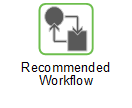ABC Classification
ABC classification allows for categorizing SKUs into different classes based on demand volume, demand value, cost, or custom characteristics. The categorization can be based on the following:
• Percentage rank (like top 20% of SKUs and next 80% of SKUs),
• Absolute rank (like top 100 SKUs, next 200 SKUs, etc.),
• Tier values (like SKUs with a cost above $1,000, between $1,000 and $500, etc.)
• Percent values (like top 80% of cumulative SKU values).
The resulting ABC classification values are stored in the custom Stock Amount table (IPCSCUST_STOCK_AMOUNT) and are available for segmentation.
ABC Classification Example
This example takes you step by step through the ABC Classification workflow. The objective is to classify SKUs by units sold and part cost for the past year.
1. Create the ABC Class Sets
Create four ABC Class Sets. The following table lists the 4 class sets and the field values.
ABC Class Set Fields | % Rank of Units Sold | Absolute Rank of Units Sold | % Value for Units Sold | Tier Values on Part Cost |
|---|---|---|---|---|
Name | ABC Units Percent Rank | ABC Units Absolute Rank | ABC Units Percent Value | Tier Values on Part Cost |
Description | ABC Units Percent Rank | ABC Units Absolute Rank | ABC Units Percent Value | Tier Values on Part Cost |
DB Column Name | ABC_UNITS_PCT_RANK | ABC_UNITS_ABS_RANK | ABC_UNITS_PTC_VALUE | XYZ_COST_TIER_VALUE |
Classification Type | Demand | Demand | Demand | |
Units/Volume | Units | Units | Units | |
Part/SKU | Part | |||
SKU Grouping | No Grouping | No Grouping | No Grouping | No Grouping |
Slice Grouping | Sum | Sum | Sum | |
Number of Slices | 12 | 12 | 12 | |
Demand Streams | Select All | Select All | Select All |
2. Restart the server
When you restart the server, the new ABC Class Sets are initialized and the DB Column Name associated with the ABC Class Set is added as a field on the IPCSCUST_STOCK_AMOUNT custom table.
◦ ABC_UNITS_PCT_RANK
◦ ABC_UNITS_ABS_RANK
◦ ABC_UNITS_PCT_VALUE
◦ TXYZ_COST_TIER_VALUE
3. Create an ABC Parameter
Create an ABC Parameter to establish the rules for the classification of the groups and define which SKUs are classified by assigning them to segments. All four ABC Class Sets will be defined to this new ABC Parameter.
Field | Value |
|---|---|
Name | Units Sold |
Description | Units Sold and Part Cost Analysis |
Enabled | Yes |
Insert Class Set | Select a Class Set and click  . You will do this four times, once for each of the ABC Class Sets defined in Step 1. The ABC Class Sets are displayed on the New/Edit ABC Parameter page as individual tabs. . You will do this four times, once for each of the ABC Class Sets defined in Step 1. The ABC Class Sets are displayed on the New/Edit ABC Parameter page as individual tabs. |
After the general attributes of the ABC Parameter are specified, you will need to define the rules for each ABC Class Set.
Classification Properties for each ABC Class Set | % Rank of Units Sold | Absolute Rank of Units Sold | % Value for Units Sold | Tier Values on Part Cost | ||
|---|---|---|---|---|---|---|
Promote Ties | Yes | Yes | Yes | Yes | ||
Tier Type | Percentage Rank | Absolute Rank | Percentage Value | Tier Values | ||
Rule 1 | 80 The top 80% of SKUs ranked by the number of units sold | 10 The top 10 SKUs ranked by units sold | 80 The top 80% of the cumulative units sold for the SKUs | 100 Part cost greater than or equal to $100 | ||
Rule 2 | 15 The next 15% of SKUs ranked by the number of units sold | Remaining Pairs | 15 The next 15% of the cumulative units sold for the SKUs | 50 Part cost greater than or equal to $50 and less than $100 | ||
Rule 3 | Remaining Value
| Remaining Value | Remaining VAlue Part cost less than $50 (the remaining value) |
The last step in defining the ABC Parameter is specifying the segments that are will be associated. For this example, the ABC_Western segment is selected.
4. Run the Synchronize Database AutoPilot Process
The Synchronize Database AutoPilot process performs the following data analysis and calculations. For this example, assume that the input data is as follows for the segment selected:
Part | Units Sold | Part Cost |
|---|---|---|
Part 1 | 40 | 200 |
Part 2 | 38 | 200 |
Part 3 | 36 | 200 |
Part 4 | 34 | 175 |
Part 5 | 32 | 175 |
Part 6 | 30 | 175 |
Part 7 | 28 | 150 |
Part 8 | 26 | 150 |
Part 9 | 24 | 150 |
Part 10 | 20 | 125 |
Part 11 | 20 | 125 |
Part 12 | 18 | 100 |
Part 13 | 16 | 100 |
Part 14 | 14 | 100 |
Part 15 | 12 | 75 |
Part 16 | 10 | 75 |
Part 17 | 10 | 75 |
Part 18 | 10 | 50 |
Part 19 | 4 | 50 |
Part 20 | 2 | 50 |
After the Synchronize Database AutoPilot job completes successfully, the results will look like the following example.
Although Promote Ties was set to Yes for this class set, the results for both Yes and No options are provided to show how the Promote Ties setting affects the results. |
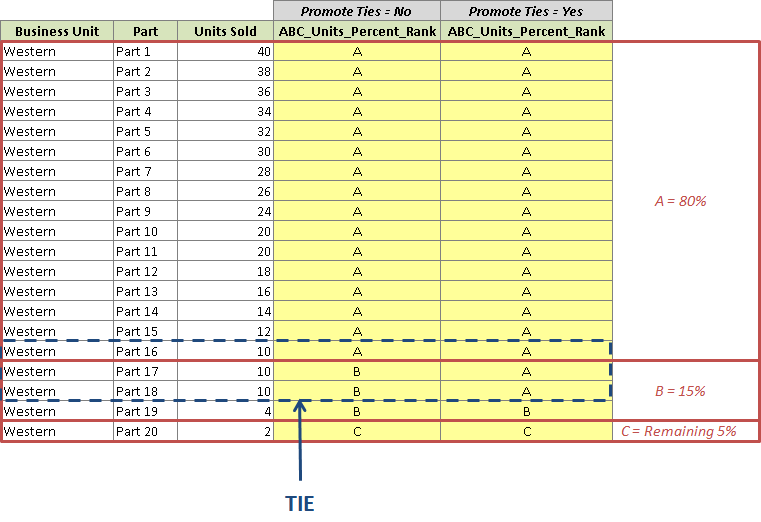
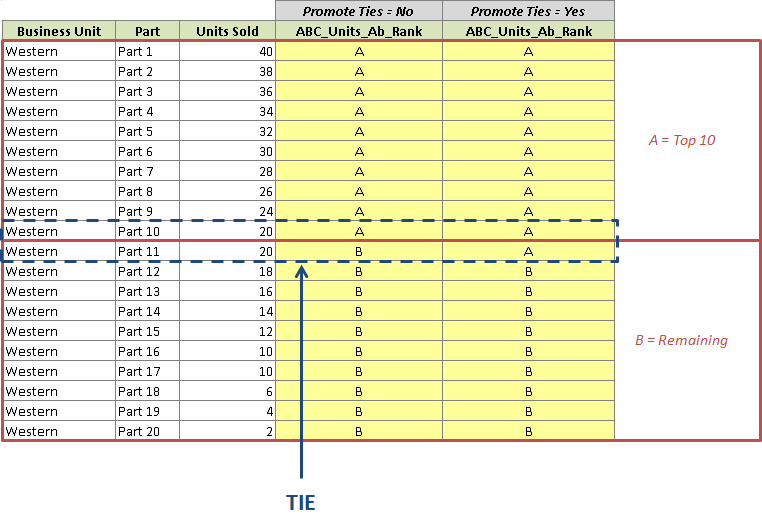
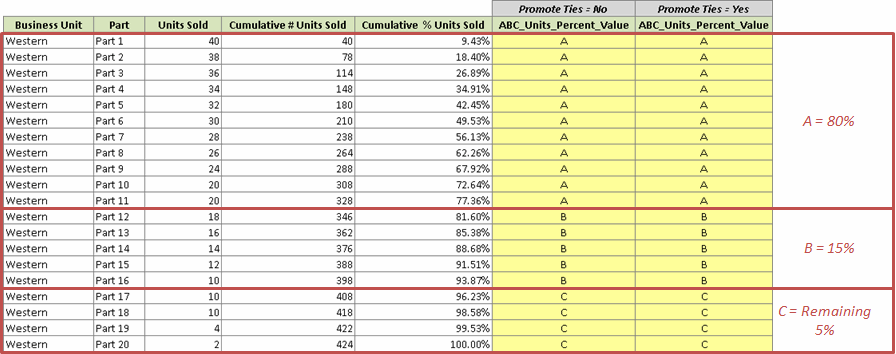
The final results after the Synchronize Database AutoPilot process successfully complete are shown in the following table.
The new XYZ_Cost_Tier_Value custom field is added to the table per the class set. The classification is the same regardless of the Promote Ties setting because there are no ties between classification groupings. |
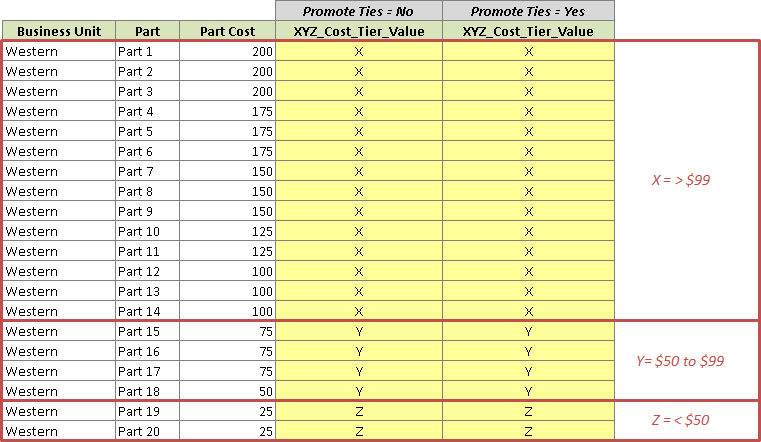
5. Use the Results for Segmentation
The results can now be used in the segmentation process.
